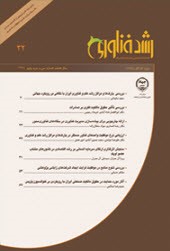ارزيابي نرخ موفقيت واحدهاي فناور مستقر در پار كها و مراكز رشد علم و فناوري
محورهای موضوعی : پارکهاي علم و فناوري و مراکز رشدعلیرضا موتمنی 1 , محمد حسین آبادی 2 , امین همتی 3 *
1 - -
2 - -
3 - -
کلید واژه: پارك علم و فناوري, مركز رشد علم و فناوري, عوامل موفقيت واحدهاي فناور,
چکیده مقاله :
شرکتهای دانشبنيان جهت تبديل ايدهها و نوآوریها به محصول و ايجاد مشاغل پايدار مبتني بر فناوري، تجاریسازی تحقيقات، همافزايی علم و ثروت و توانمندسازی و هدايت دانشآموختگان جهت ورود موفق به فضای کسب و کار ايجاد میشوند. يكي از عوامل مهم در موفقيت اين شركتها، پاركها و مراكز رشد علم و فناوري هستند كه با ايجاد ظرفيتهاي زيرساختي و حمايتهاي قانوني و تجاريسازي، ميزان موفقيت اين شرکتها افزايش ميیابد. پژوهش حاضر به منظور تعيين نسبت موفقيت شرکتهای دانشبنيان مستقر در مراكز رشد و پارکهای علم و فناوري و همچنين بررسي ارتباط ميزان موفقيت واحدهاي فناور با تعداد افراد شاغل در اين واحدها و مدت زمان استقرار واحدهاي فناور انجام پذیرفته است. جامعه آماري پاركهاي علم و فناوري موجود در ايران در سال 1390 بوده و دادههای مورد نیاز با استفاده از پرسشنامه جمعآوری گردیده است. براساس نتايج، ميزان موفقيت واحدهاي فناور، 68 درصد بوده و نتایج نشان داد نسبت موفقيت واحدهاي فناور در پارکهای مختلف با هم يكسان نيست. متوسط تعداد نيروي انساني شاغل در واحدهاي فناور موفق و ناموفق به ترتيب 5 نفر و 8/2 نفر بوده كه با استفاده از آزمون T اين تفاوت تعداد معنيدار است. همچنين نتایج نشان ميدهد متوسط تعداد شاغلين واحدهاي فناور در پارکهای مختلف با هم متفاوت است. ارتباط بين تعداد شاغلين و موفقيت واحدهاي فناور نشان ميدهد رابطه معنيداري بين اين دو وجود دارد و با افزايش تعداد شاغلين واحدهاي فناور نسبت موفقيت آنها افزايش يافته است. آزمونهای آماری همچنین رابطه معنيدار بين مدت استقرار و ميزان موفقيت را تأييد مینماید.
Knowledge-based companies are established to turn innovative ideas into products, create sustainable technology-based jobs, commercialize research, create synergy between science and wealth, and to empower and guide university graduates towards success in the business environment. A successful factor for these companies can be their involvement in science and technology parks and incubators. These parks and incubators can be considered as key infrastructures providing legal and commercial supports for these companies for leading them to success. This study aims at determining the success rate of knowledge-based firms located in science and technology parks or incubators. It also targets eliciting the correlation between the success of these companies and their number of employees. The correlation between their success and the time period during which these companies are residing at parks or incubators will also be investigated. The study will be based on a questionnaire survey on the statistical population of science and technology parks in Iran in 2010. The data collected from the current 758 tenants has been analyzed using descriptive and inferential statistics. The results show that the success rate of target companies was 68%. The chi-square test shows that the rates of success are not equal in different science and technology parks. The average numbers of workers in successful and unsuccessful tenants have been 5 and 2.8 respectively. The analysis of variance also shows the average numbers of workers are not equal in different science and technology parks. By using the chi-square test, the relationship between the number of employees and success is significant; and by increasing the number of workers, the rate of success in tenants has increased. The average duration of time within which tenants have been residing at parks or incubators has been 22 months. The chi-square test confirmed a significant relationship between their duration of stay and the success rate.

